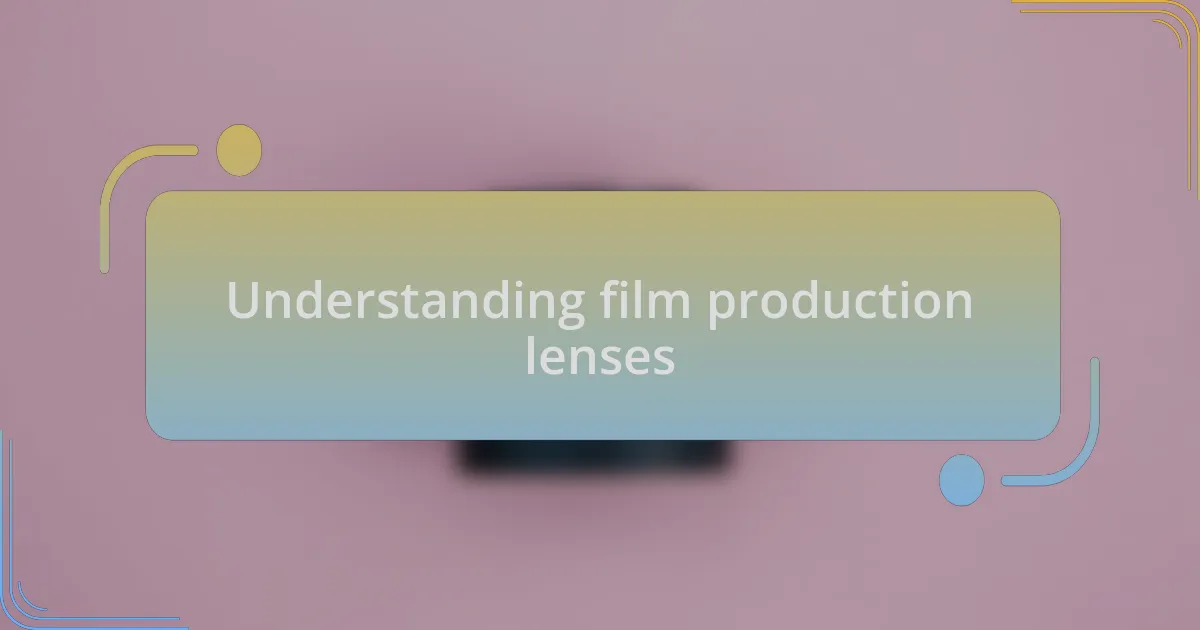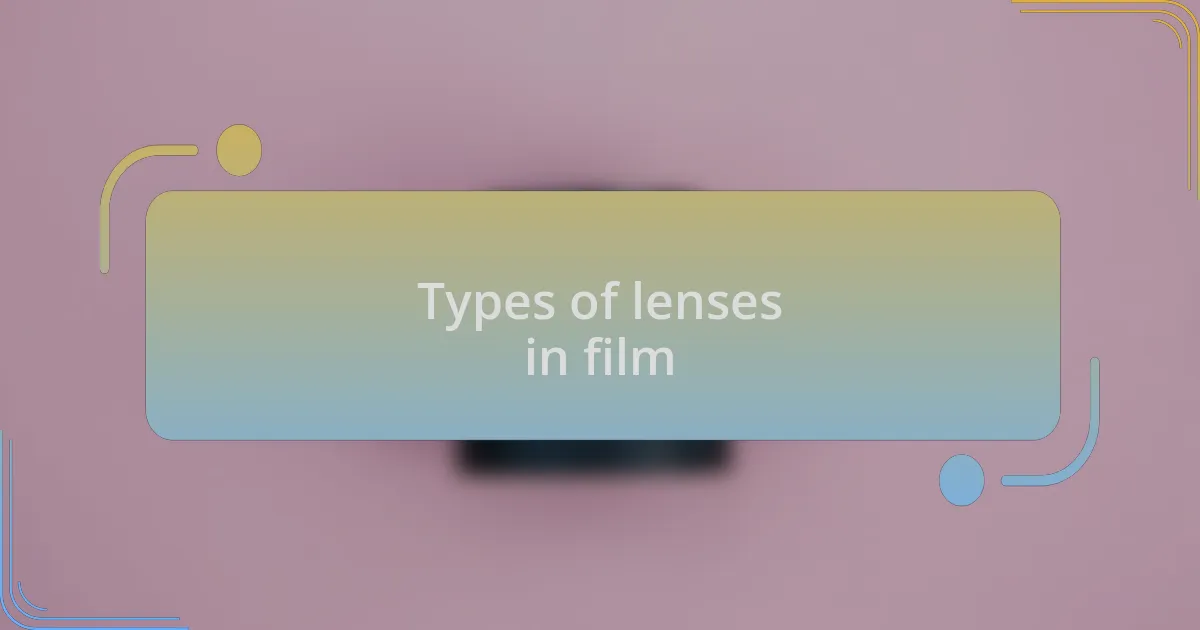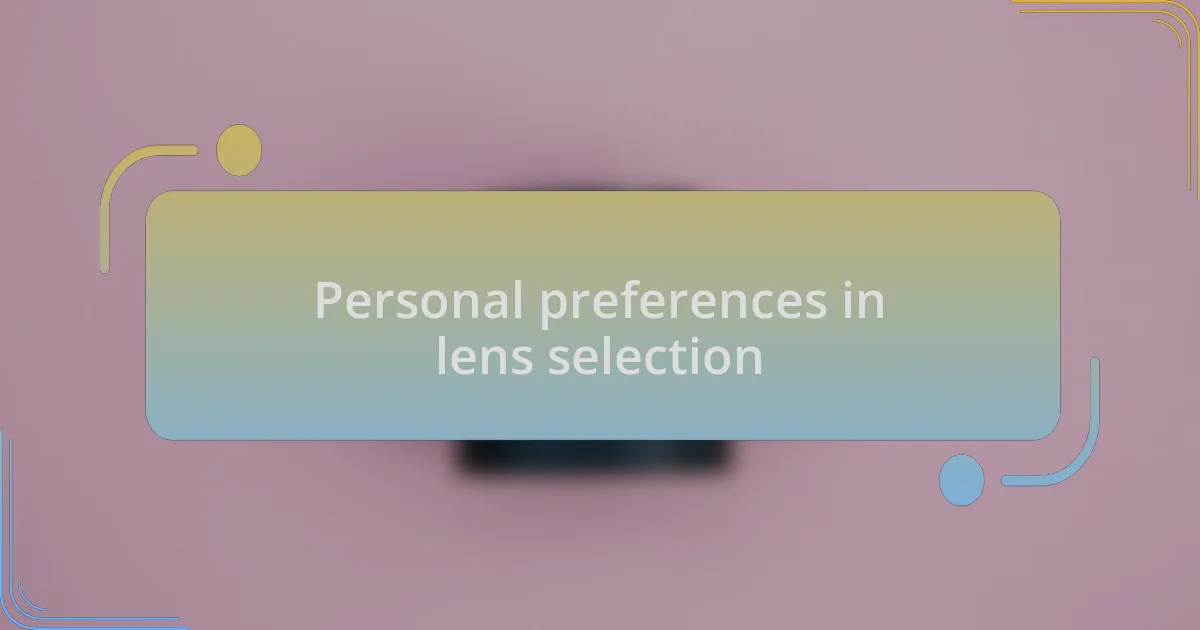Key takeaways:
- Choosing the right lens can significantly influence the emotional tone and visual narrative of a film scene.
- Different lens types (prime, zoom, specialty) offer unique advantages that can enhance storytelling and adaptability during shoots.
- Evaluating lens quality involves assessing sharpness, aberration, and bokeh effect to ensure visual and emotional impact.
- Personal preferences and familiarity with specific lenses can enhance creativity and connection to the narrative being filmed.

Understanding film production lenses
When I first delved into the world of film production, selecting the right lenses felt overwhelming. I vividly remember standing in a camera shop, surrounded by an array of options, each promising to deliver a different visual experience. The question that kept popping into my mind was, “How do I know which one to choose for my vision?”
Understanding the fundamentals of film production lenses is crucial. Different lenses can dramatically alter not just the aesthetics but also the emotional tone of a scene. For instance, using a wide-angle lens can make a space feel expansive and inviting, while a telephoto lens can compress distances, creating a sense of intimacy or tension. I’ve found that the choice often reflects my storytelling goals—am I trying to capture a sense of vastness, or intimacy?
Do you ever wonder how much a lens can influence audience perception? In one of my short films, I experimented with a vintage lens that added a charming, dreamlike quality. This choice not only enhanced the visual appeal but also evoked nostalgia, reminding viewers of cherished memories. It’s fascinating to see how something seemingly technical can profoundly impact the emotional resonance of the narrative.

Types of lenses in film
Exploring various types of lenses in film reveals the choices that can shape a narrative’s visual language. For example, prime lenses offer a fixed focal length, leading to sharper images and a more pronounced depth of field. The first time I shot with a 50mm prime lens, I was amazed by how it could isolate subjects against a beautifully blurred background, adding a layer of intimacy to my scenes.
On the other hand, zoom lenses provide the flexibility to change focal lengths without swapping lenses. I recall a time during a fast-paced documentary shoot when the ability to quickly zoom in on a subject and then out to capture the environment was invaluable. It made me realize how vital it is to adapt to spontaneous moments, ensuring I didn’t miss out on capturing raw emotions as they unfolded.
Then there are specialty lenses, like fisheye or tilt-shift, each with unique characteristics that can transform your visuals. I once used a tilt-shift lens to photograph cityscapes, giving them a miniature-like appearance that sparked intrigue among viewers. Have you ever thought about how a lens could turn an ordinary shot into something extraordinary? That’s the beauty of exploring the diverse types of lenses available in film production.

Evaluating lens quality and performance
To truly evaluate lens quality and performance, I always start by examining sharpness. During one of my initial projects, I compared shots taken with different lenses side by side. The difference was striking; some lenses delivered crisp, clean details, while others fell short, leaving me frustrated and seeking out the more reliable options. Can you imagine missing a vital moment in your story simply because the lens couldn’t keep up?
Another critical aspect I focus on is lens aberration, which can greatly affect image quality. I remember filming a scene with a wide-open aperture, where certain lenses displayed noticeable colorful halos around the edges. It was a reminder that even subtle imperfections can detract from the overall aesthetic I was aiming for. I always ask myself: how do I want the story to be perceived, and what flaws might interfere with that vision?
I also pay attention to the bokeh effect, which adds emotional depth to my shots. I once shot a close-up with a lens known for its beautiful bokeh, and the results were stunning. The way the background melted away into soft, blurred circles drew viewers’ attention directly to my subject’s expression. Isn’t it incredible how a well-chosen lens can evoke such feelings? It emphasizes the importance of evaluating not just technical specifications, but also the emotional impact that a lens can create in film production.

Personal preferences in lens selection
When it comes to selecting lenses, my personal preferences often lean toward those that balance versatility with creative flair. For instance, I have a soft spot for prime lenses because they encourage me to be more intentional with my framing. I recall a shoot where I used a 50mm lens, and as I navigated through the space, I discovered angles that I might not have considered otherwise. Isn’t it fascinating how limiting yourself can actually open up new paths for creativity?
Another key factor in my selection process is the lens’s character, which can dramatically shape the visual narrative. I once filmed a moody scene with a vintage lens known for its unique color rendition. The result was unexpected; the hues seemed to dance across the frame, adding an almost nostalgic quality to the story. Have you ever thought about how a lens can create a time and place all on its own? It reminds me that the right lens can be a storyteller in its own right.
Moreover, comfort with a particular lens brand or type can influence my choices. I find that using lenses I know inside and out allows me to focus on the story rather than the gear. There’s a level of trust that develops over time; I remember feeling a sense of ease when I used a familiar zoom lens in a fast-paced shoot. When the pressure is on, I often wonder, can we really afford to second-guess our tools? That’s why I always prioritize familiarity in my lens selection, as it allows me to connect more authentically with my work.

Lessons learned from past experiences
The journey of selecting lenses has taught me the value of experimentation. I remember a time when I had to shoot with a lens I wasn’t comfortable with for an important project. Initially, I felt anxious, but as I spent time with it, I learned how to manipulate its quirks to my advantage. It’s amazing how stepping out of your comfort zone can lead to unexpected growth. Have you ever pushed past your limits and found something remarkable in the process?
Another lesson I’ve gathered revolves around the importance of understanding the focal length you need for specific scenes. During a documentary shoot, I went in thinking a wider lens would be best, but ended up regretting not bringing a longer one. The intimacy of a close-up made all the difference in conveying emotion. This experience solidified a lesson for me: knowing your story’s requirements can guide better lens choices and shape the narrative effectively.
Lastly, it’s crucial to recognize the impact of lighting conditions on lens selection. On one occasion, I was caught off guard by the harsh afternoon sun during a shoot. I had opted for a fast lens, thinking it would suffice, but the glare was challenging. This taught me that the right lens isn’t just about specs; it’s about adaptability in varied environments. How do you prepare for the unanticipated aspects of your shoots? Embracing flexibility and being prepared can elevate the final outcome dramatically.